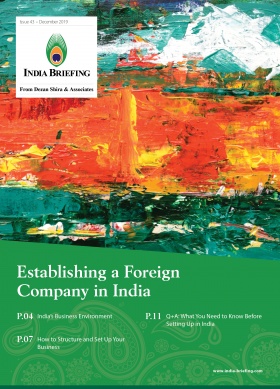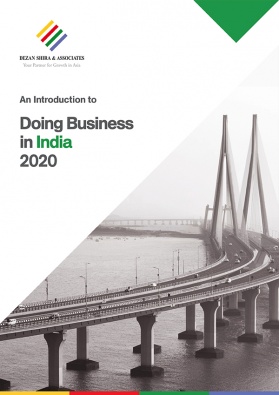Medical Devices in India: Key Considerations for Foreign Investors, Importers
Foreign businesses now have more freedom to invest in India’s medical devices industry than ever before. India presents an attractive market opportunity for global medical device manufacturers, and is keen to expand its potential as a domestic manufacturing base and climb up the value chain.
India’s medical device market ranks in the world’s top 20 and is expected to reach INR 794.29 billion (US$10.86 billion) by the end of 2023.
Given the highly competitive nature of the industry, and higher stakes in the advent of the ongoing coronavirus pandemic, India has announced new incentive schemes besides implementing regulatory reforms and expanding the scope of what constitutes ‘medical devices’.
Foreign companies looking at India’s domestic medical device industry should be careful when planning their entry strategy. Whether a foreign business intends to invest in manufacturing in India or import into India – it will need to scrutinize the Drugs and Cosmetics Act, 1940; the Drugs and Cosmetics Rules, 1945; the Medical Device Rules, 2017; and the Medical Devices (Amendment) Rules, 2020 to assess how the medical device(s) in question are treated by industry and market regulators.
As of September 2021, a new law is in the works that will change the way drugs, medical devices, and cosmetics are regulated in India. The first draft of the new law is expected by the end of November 2021. Investors and industry stakeholders are advised to keep track of these developments.
Below we discuss some of the latest developments that will impact potential investors, manufacturers, and importers of medical devices in India.
Investing in India
When foreign entities invest in India, their investment will go through one of two foreign direct investment (FDI) routes, which affects the amount they are able to invest and the investment timeline. The two routes are:
- The government route – for investment in business sectors requiring prior approval from the concerned federal ministry or department, and
- The automatic route – for investment in business sectors that do not require prior approval from the government.
Since the pandemic struck India, medical devices have been identified as a flagship industry for the Make in India program. Consequently, the government has rolled out two new initiatives – the Production Linked Incentive Scheme (PLI) and the Promotion of Medical Devices Parks Scheme.
How does the PLI scheme work?
The Production Lined Incentives scheme offers financial incentives to boost domestic manufacturing and attract large investments in industrial segments, such as cancer care devices, radiology and imaging devices, anesthetics devices, and surgical implants etc.
Companies must be registered in India and manufacture products in the respective target segments to qualify for government support under the PLI scheme.
The applicant company (or group of companies) must show a net worth of more than INR 18 crore (US$2.45 million) and must not be deemed a defaulter. Also, the project undertaking must be a greenfield investment.
Companies that avail incentives under the PLI scheme will still be eligible to apply for incentives under other schemes.
Promoting medical device parks – how does this scheme work?
The government aims to strengthen the infrastructure base and develop a robust manufacturing ecosystem for medical devices in India through the ‘Promotion of Medical Device Parks’ scheme. The tenure of the scheme will be from FY 2020-21 to FY 2024-25.
Grants under the scheme will be available to develop world-class standard testing and infrastructure facilities that will deepen the production value chain in India. This goal is to reduce the cost of manufacturing, enable better accessibility, and ensure the affordability of medical devices in the country.
Government financial assistance worth up to INR 400 crore (US$54.64 million) in grants will be provided to set up common infrastructure facilities in four selected medical device parks – the locations of which will be proposed by respective state governments.
This will be broken down as a grant of INR 100 crore (US$13.66 million) or 70 percent of the project cost (whichever is less) for each park.
Interested investors looking at locations to choose a site to develop a medical device park in India must note that the grant will be INR 100 crore (US$13.66 million) or 90 percent of the project cost (whichever is less) – in the northeast states (Arunachal Pradesh, Assam, Manipur, Meghalaya, Mizoram, Nagaland, Sikkim and Tripura), the hilly states (Himachal Pradesh and Uttarakhand), and the union territories of Jammu & Kashmir and Ladakh.
What does the scheme mean by ‘common infrastructure’?
The following facilities will constitute as common infrastructure in the medical device parks as stipulated by the scheme:
- Component testing center/ESDM/PCB/sensors facility
- Electra-magnetic interference and electra-magnetic compatibility center
- Biomaterial / Biocompatibility /Accelerated Aging Testing Centre
- Medical grade molding/milling/injection molding/machining/tooling center
- 3D designing and printing for medical-grade products
- Sterilization/ETO/gamma center
- Animal lab and toxicity testing center
- Radiation testing center
- Radiology tube/flat panel detectors/MRI magnets/ piezo electrical crystals/power electronics facility
- Solid waste management/ETP/STP/electronic waste management unit
- Common warehouse and logistics (clearing and forwarding, insurance, transportation. customs, weighbridges, etc.) center
- Emergency response center/safety/hazardous operations audit center
- Centre of excellence/technology incubator/ ITI/training centers
Latest regulatory developments and compliance requirements
Key regulatory developments in the last five years that affect India’s medical devices industry are stated below.
Update: New law in the works to replace existing Drugs & Cosmetics Act, 1940 (as on September 9, 2021)
The government is working to bring a new law to regulate medicines, cosmetics, and medical devices to keep pace with the rapid changes in the pharmaceuticals sector, market demand, and the post-COVID economy. The current regulatory regime is not well-equipped to monitor new retail avenues, among other concerns. The new law will be expected to address medical devices, hospital equipment, e-pharmacy, emergency use authorization (EUA), and compensation norms in case of EUAs, clinical trials, etc. The health ministry has constituted an eight-member expert panel, headed by the Drugs Controller General of India (DCGI), Dr V.G. Somani, to examine the existing law and submit a draft of the proposed new law by November 30, 2021. Medical device makers have previously requested the government for a separate regulatory regime for medical devices than combining with drugs regulation. It remains to be seen how the new proposed law will consider these expectations and challenges.
FDI policy liberalized
In 2015, India’s medical devices industry was opened up to 100 percent FDI via the automatic route. But the scope for investments was still restricted by the narrow definition of medical devices in the Drugs and Cosmetics Act (DCA), 1940.
Definition of medical devices expanded
In 2017, the government widened the range of items defined as ‘medical devices’ in the FDI Policy. The Medical Devices Rules (MDR), 2017 came into effect January 1, 2018.
Medical devices category expanded again
On February 11, 2020, the Central Drugs Standard Control Organization (CDSCO) notified a new definition of medical devices.
As per the notification, the Medical Devices (Amendment) Rules, 2020 effective since April 1, 2020, the definition of medical devices that fall under the following definition will be regulated as “drugs” under the Drugs and Cosmetics Act, 1940 and Medical Devices Rules, 2017 – “all devices including an instrument, apparatus, appliance, implant, material or other article, whether used alone or in combination, including a software or an accessory, intended by its manufacturer to be used specially for human beings or animals which does not achieve the primary intended action in or on human body or animals by any pharmacological or immunological or metabolic means, but which may assist in its intended function by such means for one or more of the specific purposes of: (i) diagnosis, prevention, monitoring, treatment or alleviation of any disease or disorder; (ii) diagnosis, monitoring, treatment, alleviation or assistance for, any injury or disability; (iii) investigation, replacement or modification or support of the anatomy or of a physiological process; (iv) supporting or sustaining life; (v) disinfection of medical devices; and (vi) control of conception.”
New registration requirements for manufacturers and importers
Given the amendment to the MDR, there are new requirements in the process of seeking approval to manufacture and import medical devices in India.
Starting April 1, 2020, registration details must now be submitted by the manufacturer or importer. The details must include: (i) the name of the company or firm; (ii) the details of the medical device (generic name, brand name (if it bears a registered trade-mark in India), model number, intended use, risk classification, construction material, dimensions (if applicable), shelf life, and sterile or non-sterile-status); (iii) undertaking stating the authenticity of the information provided; the certificate of compliance with respect to ISO 13485 standard accredited by National Accreditation Board for Certification Bodies or International Accreditation Forum applicable to the device; and in case of importers, additionally provide (iv) the free sale certificate from the country of origin.
The above information must be submitted to the “Online System for Medical Devices”, a web portal established by the CDSCO. Upon submission, a registration number will get generated. The manufacturer or importer must mention this registration number on the label of the medical device.
About Us
India Briefing is produced by Dezan Shira & Associates. The firm assists foreign investors throughout Asia from offices across the world, including in Delhi and Mumbai. Readers may write to india@dezshira.com for business support in India.
- Previous Article Delhi’s Electric Vehicles Market: Subsidies, Other Incentives
- Next Article Manufacturing Toys in India: Import Regime, BIS Certification, and Planned Clusters










